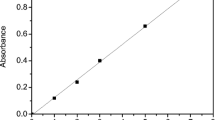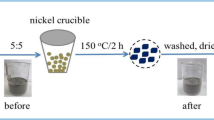Abstract
The H2SO4-modified coal fly ash can be reused as Fenton-like catalyst to treat organic wastewater effectively. The BET test shows that the specific surface area of the catalyst (24.4 m2 g−1) is smaller relatively, while the existence of Fe2O3 (5.1%, wt%) illustrates the value of H2SO4-modified coal fly ash as catalyst. The degradation of AO7 in the Fenton-like process obeys the pseudo-first-order kinetics, and the apparent activation energy, calculated by Arrhenius equation, was 19.24 kJ mol−1. Under the optimal treatment condition (catalyst loading = 10 g L−1, [H2O2] = 15 mM, pH 2.5–5.5, temperature = 298 K), the removal rate of AO7 is more than 95% at 60 min. The catalyst can be used 6 times with the removal rate of AO7 no less than 90%. The decrease in catalytic capacity is caused by the leaching and loss of Fe element. The concentrations of other leached metallic elements are lower than the standard in China. The ·OH in the Fenton-like process was generated simultaneously by the homogeneous and heterogeneous catalyses, while the heterogeneous catalysis plays a more important role. The degradation path of AO7 in the Fenton-like process is analyzed and proposed as well as per the determination result of GC–MS.







Similar content being viewed by others
References
Aravind P, Selvaraj H, Ferro S, Neelavannan GM, Sundaram M (2018) A one-pot approach: oxychloride radicals enhanced electrochemical oxidation for the treatment of textile dye wastewater trailed by mixed salts recycling. J Clean Prod 182:246–258
Asl SMH, Ghadi A, Baei MS, Javadian H, Maghsudi M, Kazemian H (2018) Porous catalysts fabricated from coal fly ash as cost-effective alternatives for industrial applications: a review. Fuel 217:320–342
Aziz KHH, Mahyar A, Miessner H, Mueller S, Kalass D, Moeller D, Khorshid I, Rashid MAM (2018) Application of a planar falling film reactor for decomposition and mineralization of methylene blue in the aqueous media via ozonation, Fenton, photocatalysis and non-thermal plasma: a comparative study. Process Saf Environ Prot 113:319–329
Behin J, Farhadian N, Ahmadi M, Parvizi M (2015) Ozone assisted electrocoagulation in a rectangular internal-loop airlift reactor: application to decolorization of acid dye. J Water Process Eng 8:171–178
Behin J, Bukhari SS, Kazemian H, Rohani S (2016) Developing a zero liquid discharge process for zeolitization of coal fly ash to synthetic NaP zeolite. Fuel 171:195–202
Behin J, Akbari A, Mahmoudi M, Khajeh M (2017) Sodium hypochlorite as an alternative to hydrogen peroxide in Fenton process for industrial scale. Water Res 121:120–128
Carrasco-Diaz MR, Castillejos-López E, Cerpa-Naranjo A, Rojas-Cervantes ML (2016) Efficient removal of paracetamol using LaCu1−xMxO3 (M = Mn, Ti) perovskites as heterogeneous Fenton-like catalysts. Chem Eng J 304:408–418
Cheng M, Zeng GM, Huang DL, Lai C, Liu Y, Xu P, Zhang C, Wan J, Hu L, Xiong WP, Zhou CY (2017) Salicylic acid-methanol modified steel converter slag as heterogeneous Fenton-like catalyst for enhanced degradation of alachlor. Chem Eng J 327:686–693
Coen JJF, Smith AT, Candeias LP, Oakes J (2001) New insights into mechanisms of dye degradation by one-electron oxidation processes. J Chem Soc Perkin Trans 2:2125–2129
Daud NK, Akpan UG, Hameed BH (2012) Decolorization of Sunzol Black DN conc. in aqueous solution by Fenton oxidation process: effect of system parameters and kinetic study. Desalination Water Treat 37:1–7
de Lima LB, Pereira LO, de Moura SG, Magalhaes F (2017) Degradation of organic contaminants in effluents-synthetic and from the textile industry-by Fenton, photocatalysis, and H2O2 photolysis. Environ Sci Pollut Res 24(7):6299–6306
Dharmadhikari DM, Vanerkar AP, Barhate NM (2005) Chemical oxygen demand using closed microwave digestion system. Environ Sci Technol 39:6198–6201
Elhami V, Karimi A, Aghbolaghy M (2015) Preparation of heterogeneous bio-Fenton catalyst for decolorization of Malachite Green. J Taiwan Inst Chem Eng 56:154–159
Guzman-Vargas A, de la Rosa-Pineda JE, Oliver-Tolentino MA, Lima E, Ramirez-Rosales D, Flores-Moreno JL, Martinez-Ortiz MD (2015) Stability of Cu species and zeolite structure on ecological heterogeneous Fenton discoloration-degradation of yellow 5 dye: efficiency on reusable Cu-Y catalysts. Environ Prog Sustain Energy 34(4):990–998
Hussein A, Scholz M (2018) Treatment of artificial wastewater containing two azo textile dyes by vertical-flow constructed wetlands. Environ Sci Pollut Res 25(7):6870–6889
Idel-aouad R, Valiente M, Gutierrez-Bouzan C, Vilaseca M, Yaacoubi A, Tanouti B, Lopez-Mesas M (2015) Relevance of toxicity assessment in wastewater treatment: case study-four Fenton processes applied to the mineralization of CI Acid Red 14. J Anal Methods Chem. https://doi.org/10.1155/2015/945489
Ifelebuegu AO, Ukpebor J, Nzeribe-Nwedo B (2016) Mechanistic evaluation and reaction pathway of UV photo-assisted Fenton-like degradation of progesterone in water and wastewater. Int J Environ Sci Technol 13(12):2757–2766
Inchaurrondo N, Font J, Ramos CP, Haure P (2016) Natural diatomites: efficient green catalyst for Fenton-like oxidation of Orange II. Appl Catal B 181:481–494
Jain SN, Gogate PR (2018) Efficient removal of Acid Green 25 dye from wastewater using activated Prunus Dulcis as biosorbent: batch and column studies. J Environ Manag 210:226–238
Karthikeyan S, Priya ME, Boopathy R, Velan M, Mandal AB, Sekaran G (2012) Heterocatalytic Fenton oxidation process for the treatment of tannery effluent: kinetic and thermodynamic studies. Environ Sci Pollut Res 19:1828–1840
Le TXH, Van Nguyen T, Yacouba ZA, Zoungrana L, Avril F, Petit E, Mendret J, Bonniol V, Bechelany M, Lacour S, Lesage G (2016) Toxicity removal assessments related to degradation pathways of azo dyes: toward an optimization of Electro-Fenton treatment. Chemosphere 161:308–318
Liu H, Liang MY, Liu CS, Gao YX, Zhou JM (2009) Catalytic degradation of phenol in sonolysis by coal ash and H2O2/O−3. Chem Eng J 153:131–137
Martinez LM, Hodaifa G, Rodriguez S, Gimenez JA, Ochando J (2011) Degradation of organic matter in olive-oil mill wastewater through homogeneous Fenton-like reaction. Chem Eng J 173(2):503–510
Murray A, Ormeci B (2018) Competitive effects of humic acid and wastewater on adsorption of Methylene Blue dye by activated carbon and non-imprinted polymers. J Environ Sci 66:310–317
Neyens E, Baeyens J (2003) A review of classic Fenton’s peroxidation as an advanced oxidation technique. J Hazard Mater 98(1–3):33–50
Özcan A, Oturan MA, Oturan N, Şahin Y (2009) Removal of Acid Orange 7 from water by electrochemically generated Fenton’s reagent. J Hazard Mater 163:1213–1220
Palas B, Ersoz G, Atalay S (2017) Investigation of the kinetics of the micropollutant removal by using environmentally-friendly wastewater treatment methods: Fenton like oxidation of Methylene Blue in the presence of LaFeO3 perovskite type of catalysts. J Fac Eng Archit Gazi Univ 32(4):1181–1191
Perez-Moya M, Kaisto T, Navarro M, del Valle LJ (2017) Study of the degradation performance (TOC, BOD, and toxicity) of bisphenol A by the photo-Fenton process. Environ Sci Pollut Res 24(7):6241–6251
Quadrado RFN, Fajardo AR (2017) Fast decolorization of azo methyl orange via heterogeneous Fenton and Fenton-like reactions using alginate-Fe2+/Fe3+ films as catalysts. Carbohydr Polym 177:443–450
Ramirez JH, Duarte FM, Martins FG, Costa CA, Madeira LM (2009) Modelling of the synthetic dye Orange II degradation using Fenton’s reagent: from batch to continuous reactor operation. Chem Eng J 148(2–3):394–404
Raval NP, Shah PU, Shah NK (2016) Adsorptive amputation of hazardous azo dye Congo red from wastewater: a critical review. Environ Sci Pollut Res 23(15):14810–14853
Shaheen SM, Hooda PS, Tsadilas CD (2014) Opportunities and challenges in the use of coal fly ash for soil improvements—a review. J Environ Manag 145:249–267
Song YL, Li JT (2009) Degradation of CI Direct Black 168 from aqueous solution by fly ash/H2O2 combining ultrasound. Ultrason Sonochem 16:440–444
Sugawara T, Kawashima N, Murakami TN (2011) Kinetic study of Nafion degradation by Fenton reaction. J Power Sources 196:2615–2620
Tee H-C, Lim P-E, Seng C-E, Nawi MAM, Adnan R (2015) Enhancement of azo dye Acid Orange 7 removal in newly developed horizontal subsurface-flow constructed wetland. J Environ Manag 147:349–355
Thiam A, Sires I, Centellas F, Cabot PL, Brillas E (2015) Decolorization and mineralization of Allura Red AC azo dye by solar photoelectro-Fenton: identification of intermediates. Chemosphere 136:1–8
Tokumura M, Morito R, Hatayama R, Kawase Y (2011) Iron redox cycling in hydroxyl radical generation during the photo-Fenton oxidative degradation: dynamic change of hydroxyl radical concentration. Appl Catal B 106:565–576
Wang NN, Chen JQ, Zhao Q, Xu H (2017a) Study on preparation conditions of coal fly ash catalyst and catalytic mechanism in a heterogeneous Fenton-like process. RSC Adv 7:52524–52532
Wang NN, Zhao Q, Zhang AL (2017b) Catalytic oxidation of organic pollutants in wastewater via a Fenton-like process under the catalysis of HNO3-modified coal fly ash. RSC Adv 7:27619–27628
Wang NN, Hao LL, Chen JQ, Zhao Q, Xu H (2018) Adsorptive removal of organics from aqueous phase by acid-activated coal fly ash, preparation, adsorption, and Fenton regenerative valorization of “spent” adsorbent. Environ Sci Pollut Res 25:12481–12490
Wee JH (2013) A review on carbon dioxide capture and storage technology using coal fly ash. Appl Energy 106:143–151
Zazo JA, Pliego G, Blasco S, Casas JA, Rodriguez JJ (2011) Intensification of the Fenton process by increasing the temperature. Ind Eng Chem Res 50:866–870
Zhang S, Yu H, Li Q (2005) Radiolytic degradation of Acid Orange 7: a mechanistic study. Chemosphere 61:1003–1011
Acknowledgements
The authors are thankful for the financial support of National Innovation and Entrepreneurship Training Program for students (18010282001/005). The authors wish to thank the anonymous reviewers for their helpful suggestions to improve the paper quality.
Author information
Authors and Affiliations
Corresponding author
Additional information
Editorial responsibility: M. Abbaspour.
Electronic supplementary material
Below is the link to the electronic supplementary material.
Rights and permissions
About this article
Cite this article
Wang, N.N., Hu, Q., Hao, L.L. et al. Degradation of Acid Organic 7 by modified coal fly ash-catalyzed Fenton-like process: kinetics and mechanism study. Int. J. Environ. Sci. Technol. 16, 89–100 (2019). https://doi.org/10.1007/s13762-018-1965-7
Received:
Revised:
Accepted:
Published:
Issue Date:
DOI: https://doi.org/10.1007/s13762-018-1965-7




